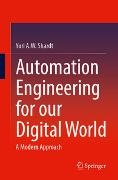Read more
This textbook presents a thorough introduction to the topic of automation engineering covering such topics as the selection and design of sensors and actuators, modelling complex processes using state-space and transfer-function models, designing control strategies, such as PID control, feedforward control, and complex model predictive control, PLCs and how to programme them, and process safety. As industry becomes more interconnected and tightly controlled with an increasing emphasis not only on profit but also on safety and the environment, there is an urgent need to understand how processes can be automated and controlled. Process automation is a complex procedure that requires understanding and modelling the process, developing an appropriate automation strategy, and finally, testing and validating it. These topics are presented rigorously with detailed examples that cover all the most commonly encountered situations. Questions at the end of the chapter expand the reader s knowledge and understanding of the topics at hand.
List of contents
Introduction to Automation Engineering.- Instrumentation and Signals.- Mathematical Representation of a Process.- Schematic Representation of a Process.- Control and Automation Strategies.- Boolean Algebra.- PLC Programming.- Safety in the Automation Industry.
About the author
Prof. Dr. Yuri A. W. Shardt is currently the chair of the Department of Automation Engineering (DE: Fachgebiet Automatisierungstechnik) in the Faculty of Computer Science and Automation (DE: Fakultät Informatik und Automatisierung) at the Technical University of Ilmenau (DE: Technische Universität Ilmenau), working in the fields of big data, including process identification and monitoring with an emphasis on the development and industrial implementation of soft sensors; holistic control, including the development of advanced control strategies for complex industrial process; and the smart world, including such implementations as smart factories, smart home, Industry 4.0, and smart grids. He has written 30 papers appearing in such journals as Automatica, Journal of Process Control, IEEE Transactions on Industrial Electronics, and Industrial and Engineering Chemistry Research on topics ranging from system identification, soft sensor development, to process control.
Summary
This textbook presents a thorough introduction to the topic of automation engineering covering such topics as the selection and design of sensors and actuators, modelling complex processes using state-space and transfer-function models, designing control strategies, such as PID control, feedforward control, and complex model predictive control, PLCs and how to programme them, and process safety. As industry becomes more interconnected and tightly controlled with an increasing emphasis not only on profit but also on safety and the environment, there is an urgent need to understand how processes can be automated and controlled. Process automation is a complex procedure that requires understanding and modelling the process, developing an appropriate automation strategy, and finally, testing and validating it. These topics are presented rigorously with detailed examples that cover all the most commonly encountered situations. Questions at the end of the chapter expand the reader’s knowledge and understanding of the topics at hand.

